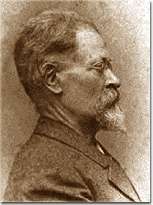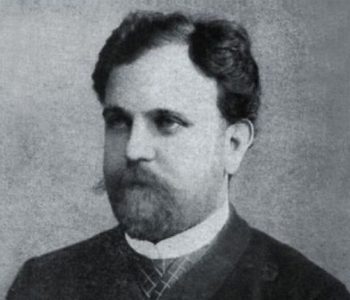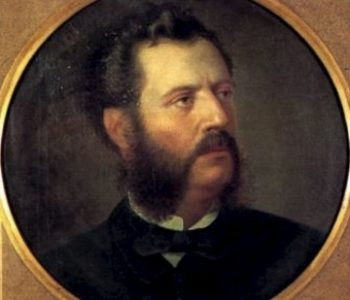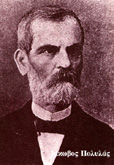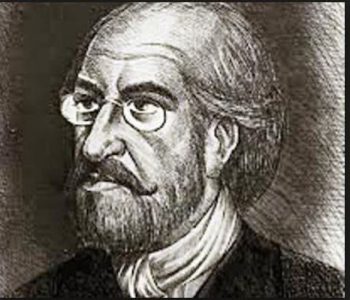
Introduction by R. Nicolì
This digital edition, within the POLYSEMI Library, reproduces two chapters (the first named Preludio alla Grecia and the last entitled Sul Jonio in volo) of Viaggio in Grecia by Mario Praz, published by Shakespeare and Kafka in 1991.[1]
The author,[2] a man of many intersecting talents, is considered one of the greatest Anglicists and the most eclectic literary critics in the twentieth century. The vastness of his works – the complete bibliography of his writings is made up of over 2,600 entries[3] – is almost unique in Italian literature.
Through this short text the author offers the reader pages that perfectly combine the essay and prosa d’arte[4] rich in erudite digressions that result from a lively intellectual curiosity. Some critics, mainly his detractors, consider Praz’s writings as a tangle where too different methods of analysis overlap[5], but we would rather apply to this travel text the view expressed by Raffaele Manica in his extremely recent monograph:[6] “La prosa di Mario Praz è un modo conoscitivo in sé che va oltre la vastità delle esperienze accumulate nel corso di una vita e consegnate a tanti libri: ha tratti spiccati, perfino abnormi, e dunque tali da farsi identificare a vista: Praz è uno stile, oltre che un conoscitore capace di variare dagli oggetti alla storia delle idee.”
His journey to Greece took place in 1931 and the writer approached that experience in the same way as the 18th-century young men prepared themselves for the Grand Tour, namely hoping to pursue ancient myths[7]. The year before, in 1930, Praz had compiled the entry on Byron[8] in the Enciclopedia Treccani and wrote the last of his articles on the English poet,[9] extolling his myth as a hero who carried his life experience to extremes. Byron became the symbol of the fight for freedom against oppression and tyranny when, convinced by his friend John Hobhouse, he embraced the principles of the London Philhellenic Committee in support of the Greek War of Independence from Ottoman rule and went to Cephalonia.
In Praz’s view, the journey to Greece – as Marcello Staglieno supposes[10] – is probably a necessary step to see at first hand what was left one century after Byron’s death, the “vero cavaliere d’Omero secondo il gusto di Alfieri” who “s’era fatto fabbricare dei fac-simili dell’elmo d’Achille per sbarcare degnamente in Grecia”. The author unfailingly thinks of Byron when he flies over Missolonghi.
Praz examines reality as an eyewitness, identifying its metaphors and deep sense; after all, in those years, many people tried to capture about Greece “il contrasto tra la grandezza passata e la presente miseria”[11], as we writes.
Actually, his journey across Greece was very short. His Spanish report Penisola pentagonale had received some criticism about the disproportion between the short time of his stay and the content, hence Praz, an outgoing, agile and curious traveler, feels the need to warn the reader that the first impressions are often the truest. In fact, the book, despite its brevity, shows the author’s eccentricity as well as richness of erudition and inclination for the unusual. His writing intersects disciplines, knowledge and ideas and follows connections that are not always predictable.
In Viaggio in Grecia we do not find that combination of grotesque and incongruity that led Edmund Wilson to coin the adjective “prazzesco”, later become famous (see other essays as Bellezza e bizzarria, Il giardino dei sensi, La crisi dell’eroe, Lettrice notturna, Perseo e la Medusa, Il patto col serpente, and Mnemosine).
Here, a balance between beauty and decline – which definitely shifts to the latter – prevails, a melancholy sense of time, where the present is totally swallowed by yesterday’s splendor contemplation. Praz looks at Greece and perceives its poverty and misery; he feels what he would have never expected to find in the “land of gods”: pity. The author reveals the gap between the idea the 20th-century traveler had about Greece, classical myth Hellas, and reality, which was disappointing and progressively abandoned: just its skeleton remains once the space of myth is eliminated.
Only Athens and Patras deserve to be considered towns according to western criteria; in the rest of Greece desolation and bewilderment prevail, “Miseria, malaria, stracci, volti gonfi o scarniti, guance gialle e occhiaie livide, teste rognose e labbra balbettanti, mani nervose che segnano l’eterno kambológion, il rosario di finta ambra a ingannare il tempo senza valore, occhi torbidi dallo sguardo tra astuto ed abietto; donne vestite di poveri cenci, colla pezzuola avvolta intorno al volto dai larghi zigomi, messe a spaccare pietre su quelle strade che non saranno mai in ordine”.
It is difficult to establish whether Mario Praz’s pages are affected by that propaganda spread in Italy in those years: less than a decade before the Second World War in the most aligned writings and in the official cultural dissemination, Rome supremacy, supported by the author, was gaining ground to the detriment of ancient Greece and often manifested itself in re-elaborating the distance between the ancient and modern Greeks.[12] Also Alberto Moravia, who went to Greece in 1938, shows how easily dominant culture could be assimilated: “Troppo spesso chi si reca in Grecia si illude di ritrovare non troppo degeneri gli ultimi discendenti dei Greci antichi”.[13]
What Praz sees is included in the broader framework of his preparatory studies. He embodies that “deliberata volontà di veder altro” already mentioned by Montale in 1928 when he reviewed the Penisola pentagonale[14]. The past may exist in Greece only if its value is enhanced by present times able to heal: “Se c’è bisogno di missioni in Grecia, c’è prima di tutto bisogno di missioni per demolire tutto ciò che s’è mal costruito nell’età moderna, e ricostruire e risanare”. Hence, he distances himself from those travelers who head for Greece carrying the excerpts from the Homeric Hymns in their pocket, as D’Annunzio, appearing as ‘declaimers of nothing’.
The second part of the Viaggio here proposed is the last part of the book. The author is travelling from Olympia to Patras on Good Friday at Orthodox Easter. The ancient legacy of animal sacrifices is in contrast with the now inauthentic modern sensibility: at every station we can hear simultaneously the moans of lambs and the groan of a fat German woman, who grotesquely bites into a chicken leg while she cries over the massacre of the animal entrails that touches her.
The procession description, with its ostentatious and evident paradigm of sacredness, offers a sound dichotomy: the solemn songs chanted by arranged groups are in contrast with the irregular chatter of the remaining crowd, as happens elsewhere, in Southern Europe: “Pensai alle processioni spagnole e a quelle del nostro Mezzogiorno”, Praz writes.
The vehicle used to return to Italy is a seaplane. The view of the Ionian Sea and the last strips of Greece show their shapes “che gli occhi della Storia hanno scrutato per secoli” and make the flight surprising and aesthetically satisfying.
As myths are re-echoed by the sound of the place names, there is a predominance of visual impressions the sea offers in all its possible shades, from turquoise to blue and from grey to emerald, depending on whether it surrounds Ithaca, Lefkada or Paxi. In the last lyrical and digressive pages, in which the writer says goodbye to Greece, all his liveliness emerges: from that special perspective, he is intent in capturing the sky, land and sea colors, describing moods and searching for quotations by Thucydides, Berchet, Byron, Virgil, Homer and so on.
The landscape portraits merge seamlessly, from the Greek Islands to Puglia with its white houses “come torri d’avorio immacolato”, scattered on the “landa cretosa e screpolata del tavoliere”. More than forty years later, the famous Anglicist will write, together with Folco Quilici, the book on Puglia, the further development of a project aimed at making a series of documentary films on the Italian regions, L’Italia vista dal cielo. Here he will confirm the first Apulian impressions he had during his return journey from Greece: “L’immenso piano della campagna, leggermente ondulato, il mare così maestoso, il cielo così infinito e sereno costituiscono una trinità grandiosa e singolare”.[15]
However, as Staglieno states in the afterword, “assai più congeniali delle ‘nudità naturali’ gli erano le strutture architettoniche”, and thus the last wonderful portrait is devoted to Castel del Monte, the “sonetto di pietra”. Flying over it, in a quick association – the memory of the myth of Amphion, who drew and arranged the mountain stones – Greece returns, since it is wider than its borders indicate.
-
The text firstly appeared in the «Ambrosiano», from April to June 1931 and later as a book named Viaggio in Grecia: diario del 1931, Ed. di lettere e viaggi, Roma, 1942. ↑
-
A detailed bibliography of the critic is avalaible online on the Treccani website at: http://www.treccani.it/enciclopedia/mario-praz/ last accessed on 2 July 2019. ↑
-
See: V. e M. Gabrieli (a cura di), Bibliografia completa degli scritti di M. Praz, Edizioni di Storia e Letteratura, Roma, 1966, nuova ed. 1997. ↑
-
N.d.T.: In Italian culture, it is a short literary text in which stylistic aspects have a key role. ↑
-
Benedetto Croce’s cruel opinion is particularly famous. In 1931, when Praz made his journey to Greece, the critic reviewed La carne la morte e il diavolo by Praz in his own magazine «La critica», XXIX, 2, 20 marzo 1931, pp. 133-134. ↑
-
Raffaele Manica Praz, ItaloSvevo, Trieste-Roma, 2018. It is the most recent monograph on the author. ↑
-
See: Marcello Staglieno, La Grecia e altri viaggi, postfazione a M. Praz, Viaggio in Grecia, Shakespeare and Kafka, Roma, 1991, p. 89. ↑
-
Available online at: http://www.treccani.it/enciclopedia/george-gordon-byron_(Enciclopedia-Italiana)/ last accessed on 3 July 2019. ↑
-
M. Praz, Lord Byron, in «La cultura» Roma, 1930 ↑
-
See: M. Staglieno, afterword to La Grecia e altri viaggi, cit. ↑
-
M. Praz, Il mondo che ho visto, Adelphi, Milano, 1982, p. 4. ↑
-
See: A. Coppola, L’immagine della Grecia in età fascista, «Anabases», n. 23, Anno 2016, p. 169-174. ↑
-
E. Siciliano (a cura di), Alberto Moravia. Viaggi. Articoli 1930-1990, con introduzione di E. Siciliano e postfazione di T. Tornitore, Meridiani Mondadori, Milano, 1972, p. 387-457. ↑
-
E. Montale, review of Penisola pentagonale in «Solaria», marzo 1928. ↑
-
M. Praz e F. Quilici, Puglia, Amilcare Pizzi Editore, Milano, 1974, p. 7. ↑


